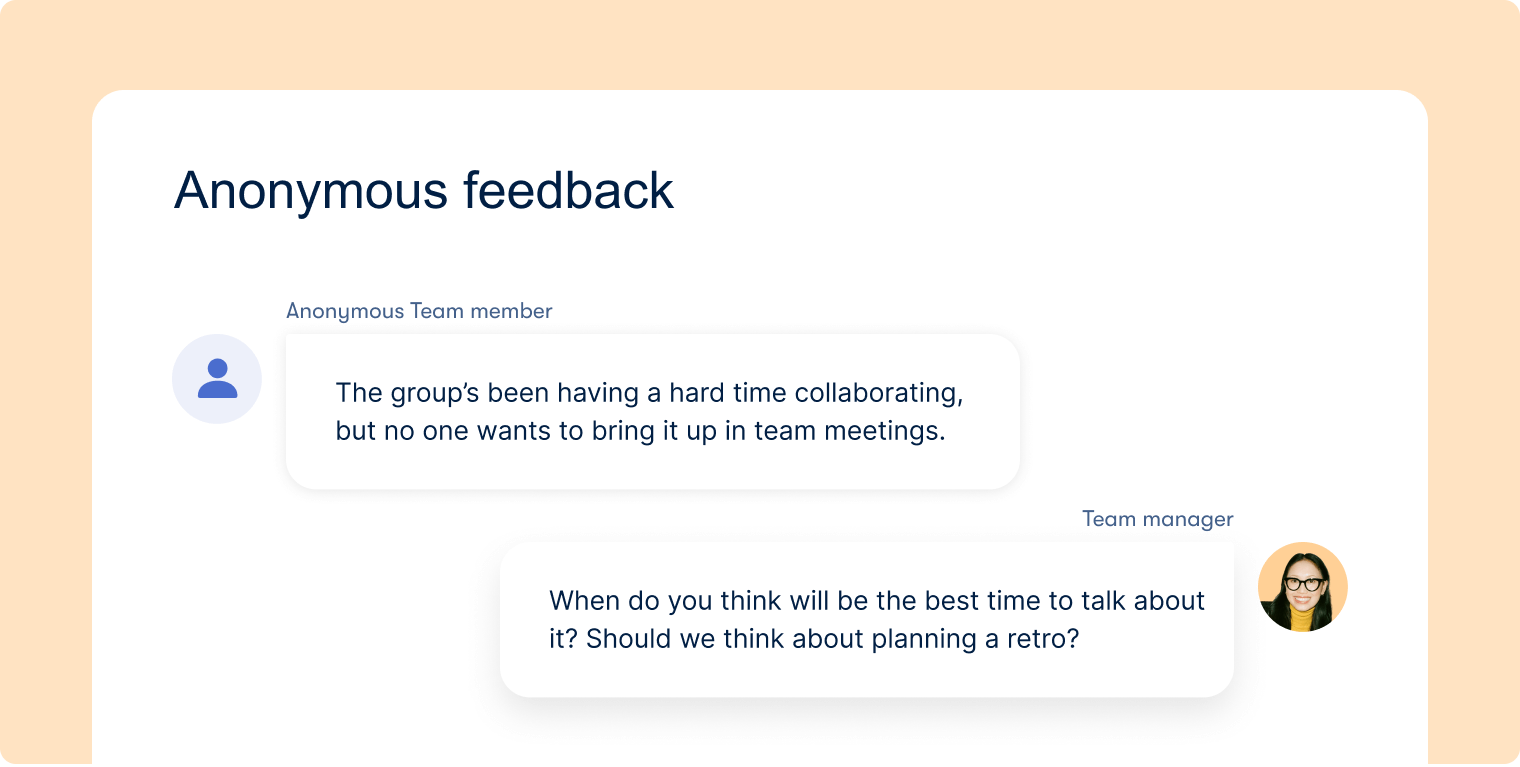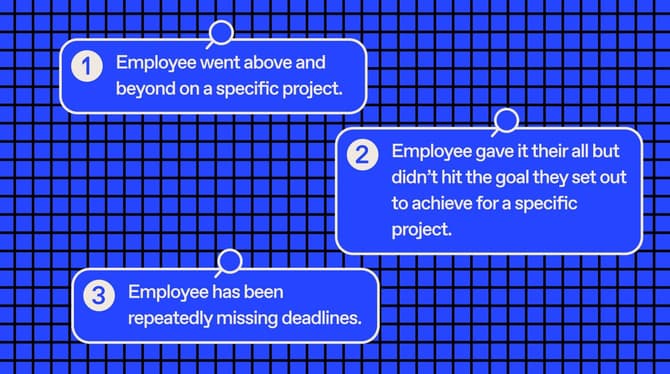One of the biggest frustrations for employees who take the time to give thoughtful feedback is feeling like their comments are ignored by their peers, manager, or organization.
As a manager and the direct line of contact for your team to the rest of the organization, there are few things more important than knowing how to effectively communicate with your employees.
But if you’re managing a growing distributed workforce, it can be challenging to dedicate enough time to craft a perfect response for your direct reports.
If you’re looking for strategies to better review and respond to constructive, negative, or even positive feedback in the workplace, we’ve got you covered.
Exclusive online summit
·
May 23 2024
Moments that matter: how to seed great work
What's in this article
Why you should respond to feedback
If someone on your team has taken the time to give you valuable feedback, it means they truly are invested in nurturing a relationship with you. Not only that, it shows that they are engaged, driven, and inspired at work. People rarely take the time to give feedback if they don’t care.
Build trusted relationships
Collaboration and trust are at the center of what makes for a great team, and responding to feedback shows that you trust the person’s opinion and value their input. So, you don’t want to miss out on this relationship-building opportunity.
30% of employees don’t feel like their companies give enough importance to their opinions and suggestions.
Officevibe’s Pulse Survey data
Open a feedback channel: Show employees that you’re open to feedback by giving them a dedicated space to share it. Officevibe’s anonymous feedback software lets team members share their ideas, suggestions, concerns, and questions with their manager, with an option for anonymity.
Managers respond to feedback directly in the app, turning it into a two-way conversation while employees can choose to remain anonymous or not.

Foster open communications
You might have heard of an employee feedback loop before, and rightly so: it’s a vital practice to develop any high-performing team. A feedback loop is created when colleagues continuously give each other feedback to:
- Improve company performance
- Achieve collective goals
- Boost employee engagement
- Enhance the employee experience
Responding to constructive feedback is key to making a feedback loop effective. Why? Because receiving feedback enthusiastically validates the other person’s act of giving it, and reinforces their instinct to keep up this positive behavior.
The more effort your team puts into offering feedback, the more people will feel safe sharing their suggestions and ideas, and the more open they will be to receiving feedback. You will constantly improve your outcomes because people are communicating openly with one another about issues as they arise.
Before responding to feedback
Reacting to feedback is a normal part of figuring out how to respond to it. Your reaction may vary depending on the scenario, and could be:
- Agreeing with the feedback
- Disagreeing with the feedback
- Needing more information to make use of the feedback
Making an effort to notice your reactions is a good first step. When you’ve identified how you’re reacting, it’s easier to come up with your response based on the nature of the message. Feedback will often be positive, negative, or constructive. Let’s discuss how to best respond in each scenario.
How to respond to positive feedback
Getting positive feedback can feel both rewarding and validating. Positive feedback might sound like: “Great work on that project! I was so impressed with how you managed the whole thing.” Or, “You’ve been so attentive lately in our virtual meetings, it’s great to sense that engagement even through the technology barrier.”
But it’s equally important to know how to respond to positive feedback to create a genuine relationship with your employees.
Check out our 16 positive employee feedback examples to promote engagement, encourage positive behavior, and reduce attrition.
Responding to positive feedback in the workplace
- Thank your employees and let them know you appreciate hearing their positive review. Let them know how it impacts you, or if you had any doubts about your own performance.
- Ask them to expand on what they thought you did well. This is important to understand the exact behavior that was well-received.
For example: “Thank you so much for the kind email. It means a lot to know that my work was appreciated and that you see the impact. If possible, I’d love to get a better understanding from your perspective of which part of the projects you felt went well, and why.”
It’s important to encourage positive feedback as much as possible, as this creates a culture where people continuously lift each other up. People tend to associate feedback with something negative or intimidating, but meaningful recognition from colleagues can really drive employee engagement.
If you can break that association by encouraging (and sharing) positive feedback, people won’t shutter as much when they are given tougher but critical feedback… and you won’t, either.
How to respond to positive feedback from your boss
Who doesn’t enjoy hearing from their manager that they’ve written an excellent report or that their recent presentation was delivered flawlessly? Unfortunately with the new reality of distributed work, opportunities for casual positive interactions and feedback have become more infrequent.
Many employees are used to hearing from or interacting with upper management only when there is an issue that needs addressing, so knowing how to respond to a “job-well-done” or other compliments can sometimes feel like uncharted territory.
When you receive a compliment or an excellent performance review, thank your boss and let them know you appreciate the kind words.
You can even go a step further and ask them to provide you with more feedback on what you did well so you can apply it to future projects: “Thank you for acknowledging my efforts! I put a lot of work into this project and I appreciate the recognition. I would love to be able to continue with this kind of performance if you could provide me with more details on which parts you thought I excelled at. This type of critical feedback is really helpful for my professional development.”
Responding to feedback that’s negative
Receiving negative feedback can be painful and even cause us to get defensive. But it’s important that you are able to mindfully respond, versus emotionally react.
When you receive criticism, wait to respond. Take a deep breath and remind yourself that feedback is not personal or a reflection of who you are as a person. If you feel hot emotions start to bubble up, give yourself some time (or ask for some) to process this critical feedback. You don’t want to risk saying something you’ll regret later.
Things to consider when responding to negative feedback
- Ask yourself if there is truth to their negative review. If you can find something to agree with, say “Thank you for pointing this out to me. I appreciate you taking the time to share this with me, and I will definitely consider this feedback moving forward.”
- If you don’t agree with the feedback, or you need more information to understand their perspective, you can respond with a probing question. Try: “I’d love to better understand where this perspective is coming from. Could we set some time to talk about it face-to-face?”
- Take time to reflect on the feedback. Ask yourself: “Is this something others have brought to my attention before?” If the answer is yes, it might be worth digging deeper.
Avoid responding to critical feedback with another negative comment. Remember that you can always simply say “thanks for sharing this” and move on. It’s your decision how much of this feedback you want to take in, and what you’d like to reject. Appreciate that this person went out on a limb to share their thoughts with you.
Get a gut check: If you’re reacting strongly to some negative feedback, first, remember it’s only one person’s opinion. Seek out a trusted colleague or friend to run it by and get their perspective on it. Together, you might be able to make it more constructive.
Responding to feedback that’s constructive
Constructive feedback usually feels less harsh since that person has not only taken the time to point out an issue but wants to be a part of the solution. Try to see this as an opportunity for collaboration and learning, regardless of who it’s coming from.
Tips to respond to constructive feedback
- Let the person know how giving you this specific and actionable feedback has been helpful for you.
- Open up the opportunity to work together on the solution. It could be a chance for you both to learn from one another, depending on the context.
- Let the person know that you’ve actioned the feedback and close off that feedback loop (if there is something actionable for you to complete).
- Reflect on what has been shared. How can you now apply the feedback going forward in different contexts?
For example: “Thank you for taking the time to share your thoughts and your ideas for moving forward. Would you be interested in finding a solution together? Your suggestion inspired me, and I have some thoughts on how we could build on this. Either way, I’ll get started on it next week.”
Responding to feedback by email
While many managers prefer to respond to negative or constructive feedback in person or through video chat, jotting down your thoughts over email can pack the same punch if done properly.
When responding to feedback via email, especially if it’s negative, you should remember to:
- Be clear with your words and tone
- Do not leave room for interpretation
- Give context to the situation
- Include past communications or screenshots to illustrate your point
If you need guidance on what to include in your email, we got you! Try our email templates to respond to negative feedback in a way that fosters open communication and respect.
When receiving a positive comment from a team member, make a note to reply to them by end of the day to thank them and acknowledge their kind words. If you’d like to hear more from them, book a one-on-one meeting to keep the conversation going.
Show people their opinion matters to you
Taking the time to thoughtfully respond to feedback at work shows that you care and that your colleagues’ ideas and opinions are valuable. Whatever type of feedback you may receive, remember to always respond with empathy and compassion, and remind yourself that all feedback is helpful to your growth as a manager.
With Officevibe’s intuitive employee feedback tool, you can collect feedback from your team, identify any alignment issues, reassess priorities, and resolve conflicts during one-on-one meetings — all in one convenient and easy-to-use platform.



